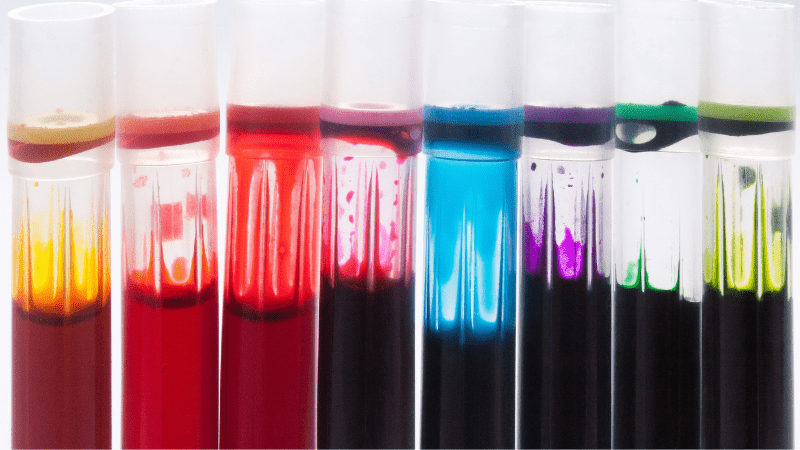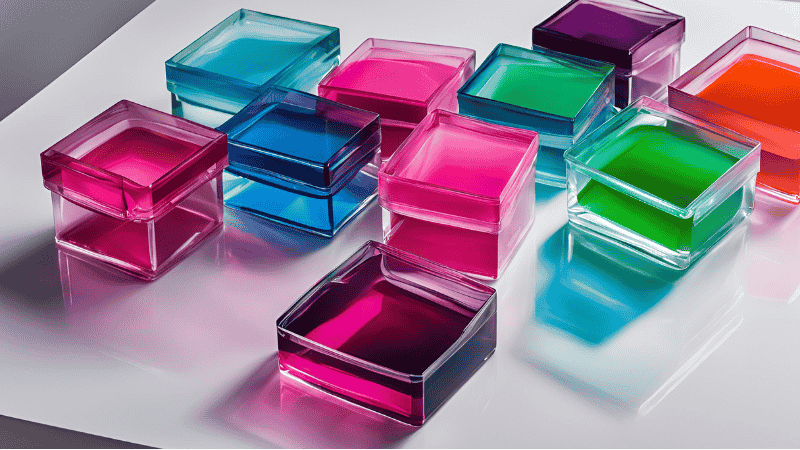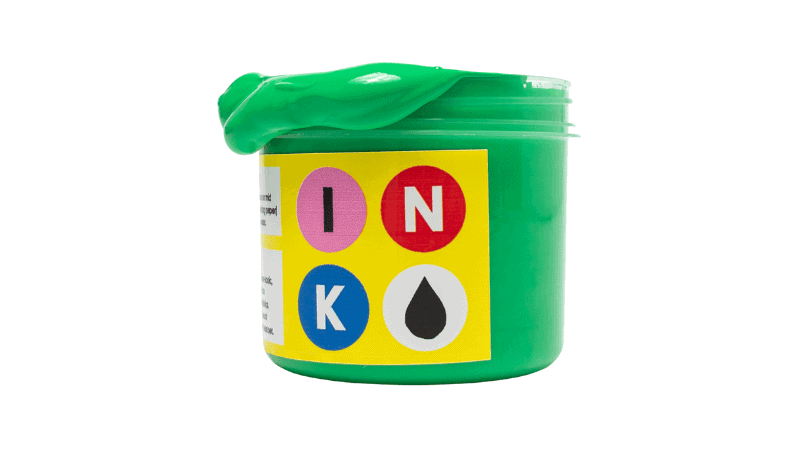Last Updated on February 26, 2025 by Packoi Team
In an era where sustainability takes center stage, the choices we make in every aspect of our lives have a profound impact on the environment. When it comes to packaging, the ink we use can make a significant difference. Join us on a journey to discover how you can make your packaging not only visually appealing but also environmentally responsible.
In this comprehensive guide, we’ll explore the world of eco-friendly inks and contribute to a greener, more sustainable future. Let’s embark on this transformative path towards a cleaner, brighter, and more environmentally conscious way of printing packaging.
What Is Environmentally Friendly Ink?

Environmentally friendly ink refers to sustainable ink that does not contain oil-based pigments and has lesser amounts of volatile organic compounds (VOCs) than petroleum-based inks. The organic compounds that make eco-friendly inks are recyclable and break down faster than petroleum-based ink.
Sustainable inks include vegetable, UV, algae, and water-based inks. Vegetable-based inks do not contain petroleum oil and instead use sustainable sources like soy, Chinese wood oils, cottonseed, tung, and linseed.
These inks are also designed to print in a manner that significantly reduces the release of VOCs. Soy-based ink is especially popular among printers keen on reducing their carbon footprint owing to its cost-effectiveness and ability to produce quality and vibrant colors.
Algae inks are widely touted as the most sustainable since they have a negative carbon footprint. Algae inks are renewable, biodegradable, VOC-free, and sustainable. Water-based inks are another suitable alternative to petroleum-based inks, particularly for highly absorbent substrates.
They are eco-friendly, sustainable, and contain limited amounts of VOCs. UV inks are also more sustainable than petroleum-based inks since they do not require additional coatings or protectants and release the fewest VOCs. On the whole, green ink is the printing industry’s future as the world moves away from its dependence on petroleum.
Why Should You Use Friendly Ink for Printing Packaging Materials?
You should use eco-friendly inks for printing packaging materials because it is the right direction toward sustainable packaging and the sustainable printing industry. Conventional printing substrates have a negative environmental impact since they are non-renewable and non-recyclable and take a long time to deteriorate.
More consumers are pushing for sustainable production and are hesitant to buy from a brand that claims to be “green” or “environmentally conscious” but whose activities or products hurt the environment. According to Asia Pulp & Paper, 56% of American consumers want more sustainable packaging.
Using eco-friendly inks for printing packaging materials is suitable for the brand. Renewable and recyclable inks communicate the brand’s commitment to environmental sustainability tangibly and earnestly. It lets the customers know that you are not just paying lip service but are committed to improving the overall sustainability of your products.

Environmentally friendly inks are made from renewable, biodegradable, and recyclable resources. The organic compounds are not only renewable, but they can also be safely disposed of since they quickly degrade and return to nature Non-petroleum-based inks also contain fewer toxic chemicals and little to no heavy metals as compared to traditional inks.
Another reason to use sustainable inks is their cost effectiveness: soy-based inks and algae inks provide the same quality of print as conventional inks at a fraction of the cost. Sustainable inks, like vegetables, are thinner and more transparent than traditional inks.
Consequently, fewer pigments are used to attain the same color intensity during printing. Soy ink is preferred by green printers for its ability to provide accurate and bright colors, an essential factor in ensuring the quality and effect of product packaging. Moreover, renewable inks are non-toxic and can safely package food.
The Different Types of Environmentally Sustainable Inks
Although I previously highlighted the different types of environmentally sustainable inks, this section will discuss them in more detail.
1. Vegetable-Based Ink

The first type of green printing ink is vegetable-based ink. These inks use stable vegetable sources like canola, China wood, linseed, castor, soy, and safflower with good wetting properties and the ability to carry solid pigments.
Most manufacturers of vegetable ink blend different sources to leverage the unique properties of each compound. Soy-based inks are one of the most popular choices among vegetable inks because of their high performance, low VOC emissions, and cost-effectiveness.
2. Water-Based Ink
The second type of green printing ink is water-based ink. These inks are made of polyurethanes and hybrid acrylic resins, although they use water as the primary solvent for carrying solid pigments. However, water-based inks are more expensive than other sustainable inks.
However, they provide a softer print than conventional substrates because the inks comprise soft resins, and all the primary solvents dry up during the curing process.
3. UV Ink

The third type of green printing ink is UV ink. These inks contain monomers and initiators that polymerize into a hard film after exposure to UV light. They also emit a few VOCs and produce a very high-quality print owing to their fast curing rate and the fact that the substrate does not evaporate but ultimately sets into the film.
4. Algae Ink
Finally, the fourth type of green printing ink is algae ink. These inks utilize algae cells to make a net-negative carbon black pigment. Algae ink has no heavy metals or VOCs. Unlike other sustainable inks that are not entirely renewable, like vegetable-based inks and water-based inks, algae inks are sustainable and have no negative environmental ramifications.
What is the Most Sustainable Printing Ink?
The most sustainable printing ink is algae ink. Recycling the waste from the toner cartridge is possible, and the paper print quality is comparable to other inks. Algae ink is a living ink since it is the only green ink with a negative carbon footprint. Each bucket of carbon ink absorbs as much carbon as two trees.

It is also safer to work with owing to its biodegradability: unlike traditional inks, which take time to degrade, algae ink breaks down quickly in nature. Algae ink is also completely sustainable, unlike other vegetable-based inks, since it does not contain any petroleum-based pigments.
How Does Environmental Friendly Ink Compare to Traditional Ink in Quality and Performance?
Sustainable inks compare favorably to traditional ink in terms of print quality and performance. For instance, soy-based inks are widely used in commercial printing because they contain organic and recyclable compounds without sacrificing quality.
For a printing company, the biggest concern is how the business can be eco-conscious without compromising the quality of its print products. Most companies want sustainable solutions that still meet their intended uses. Vegetable and water-based inks are biodegradable and viable and provide high performance in terms of printing.
For instance, soy-based ink produces sharper and brighter colors than conventional ink. Soybean oil is more transparent than petroleum-based substrates, and the pigments reach their full potential, resulting in rich, bright colors.
One of the reasons soy oil has found increasing use in commercial printing is that it delivers a high-quality print with superior lithographic stability throughout the whole print job (inks with high lithographic stability translate to fewer revisions during production). Moreover, soy has excellent rub resistance, a critical factor in newspaper and book production.
Water-based ink is another green alternative favored for its excellent performance in high-speed roll-to-roll yardage printing. The ink’s high curing capacity and superior penetration are desirable in fabric printing. UV ink is also preferred for its superior screen stability and color consistency.
UV inks enhance print quality and productivity due to their excellent rub resistance and chemical resistance compared to conventional substrates.
How Can You Make the Switch to Using Sustainable Inks in Your Business?
You can switch to using sustainable inks in your business by doing away with petroleum-based ink, buying remanufactured ink cartridges, or using remanufactured toner cartridges. One of the most effective ways to switch to sustainable printing is by focusing on using sustainable ink in all printing and recycling all waste ink from the printer.
The ink’s oil content should be petroleum-free; inks like vegetable oil, water-based ink, and UV ink are eco-friendly and have little to no adverse environmental effects. Moreover, using remanufactured toner and printer cartridges will significantly reduce the carbon footprint and impact on natural resources.
Remanufactured ink cartridges may have mixed results for the environment, but they use less traditional ink than standard cartridges.

Conclusion
In conclusion, environmentally sustainable inks are the future of printing and a sustainable world. These inks are cost-effective since they are manufactured using viable and easily accessible resources. Green printing inks are also recyclable and biodegradable.
Although some organic inks have small amounts of VOCs and heavy metals, they have fewer negative impacts than conventional substrates. It is, therefore, important for printing companies to transition away from petroleum-sourced inks to more viable substrates like soy and water-based ink types.
Get Sustainable Printing Services From Us
Are you looking for a printing company that takes environmental sustainability seriously? Packoi Printing is one such company. The printing business provides many eco-packaging solutions to customers who want recyclable, renewable, and customized printing solutions.
Supporting printing businesses committed to using sustainable inks is the most effective way to revolutionize the industry. Contact us quickly!




